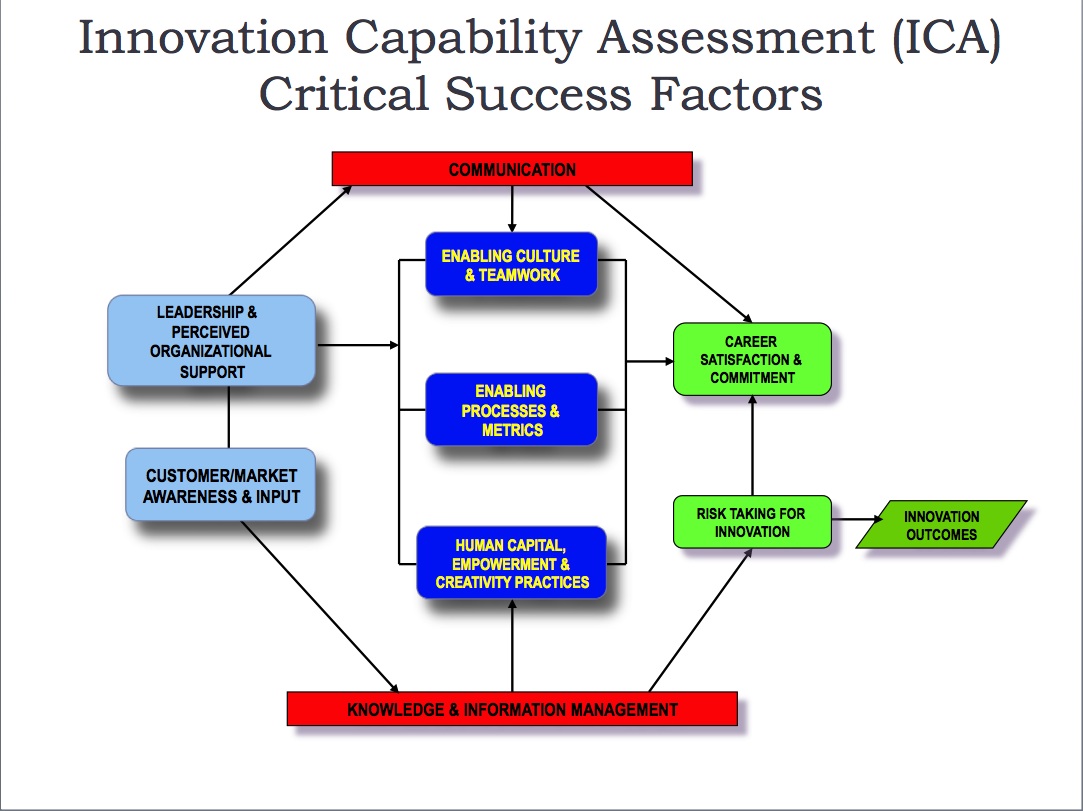Assessing Innovation Capability
Based upon a review of innovation literature over the past decade (see a sample of books and articles on creativity and innovation here), The Scalpone Group built a survey tool called the Innovation Capability Assessment to determine an organization’s capacity for successful innovation. This survey assesses 13 critical enabling factors supporting innovation at the organizational level. A norm base for the survey has been collected and currently includes more than 200 companies currently engaged in new product development. Respondents in this norm base who have rated their respective organizations are employees and managers actively working in new product teams.
To successfully develop and commercialize new products and services, organizations need a number of critical enabling factors in place. These factors start with Leadership and Customer Focus as the drivers of innovation. The outcomes of the innovation process include Risk Taking and a kind of Career Satisfaction & Commitment that energizes people who create Innovation Outcomes – new products, services, works of art, or a combination of all three. What lies in between the drivers and outcomes is an “organizational delivery system” consisting of people with the right skills and information, working within an information-rich supportive team culture. Enabling factors are depicted in the diagram below.
 First, leaders must commit to innovation as a long-term endeavor and forsake their fixation on short-term results. Innovation is a journey – a way of life, really – where the road to success is paved with the hard cobblestones of failed attempts. Consider, for example, the hundreds of light bulb filaments tested by Edison to find one that lasted long enough, or more recently, Sir James Dyson’s 5000+ prototypes to develop the bagless cyclone vacuum cleaner. Clearly, these innovators didn’t give up easily.
First, leaders must commit to innovation as a long-term endeavor and forsake their fixation on short-term results. Innovation is a journey – a way of life, really – where the road to success is paved with the hard cobblestones of failed attempts. Consider, for example, the hundreds of light bulb filaments tested by Edison to find one that lasted long enough, or more recently, Sir James Dyson’s 5000+ prototypes to develop the bagless cyclone vacuum cleaner. Clearly, these innovators didn’t give up easily.
Innovating firms also have “listening posts” to recognize potential opportunity areas that exist within the marketplace. The innovators who work in these firms are curious – they’ve observed and listened to potential customers, understand what the customers are trying to do, and empathize with customer needs and problems.
Moreover, these innovators rarely work alone. More often, the new product concept is kneaded and shaped by cross functional teams of people with complementary skills, working within a supportive culture. These teams apply a wide range of creative and technical tools to carefully prototype, test, and evolve product design into a form that’s both emotionally compelling and technically feasible, and makes sound business sense.
Innovating organizations empower their teams to test ideas and give them access to the information and technical expertise needed to get them over any roadblocks in their path. Organizations that do this effectively also have the right tools and metrics in place to manage a portfolio of innovation projects. At the same time, they select and assign the right people to do this work, trust these people, and avoid micromanaging them.
If all of these success factors are in place, the organization will see energized and committed people taking a lot of risks, people who are willing to “fail up” (to use Tavis Smiley’s term) for the occasional thrill of bringing a new product or service creation into existence.
If you would like to complete an Innovation Capability Assessment for your company, business unit, or other organization please contact The Scalpone Group at